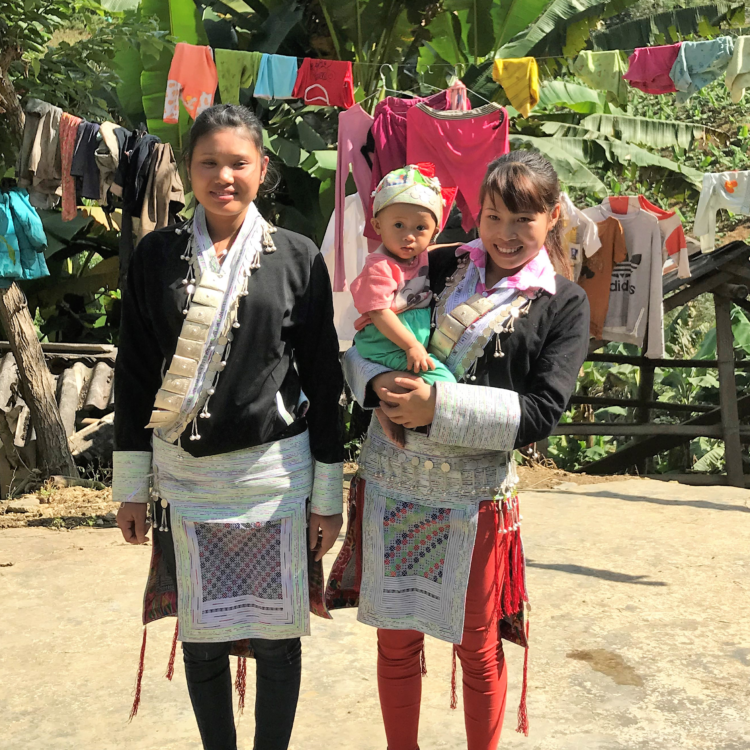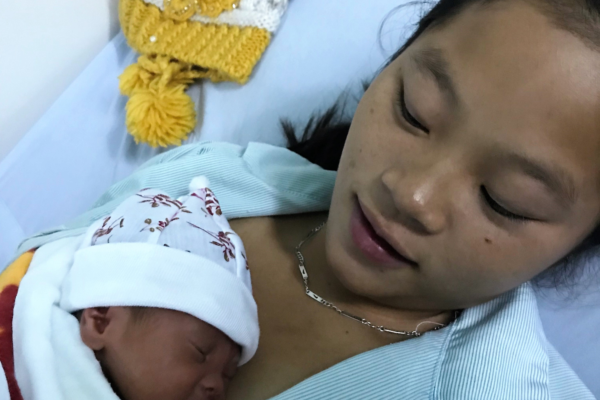Caring for Maternal Health Needs in Indigenous Communities with Local Midwives

Vàng Tả Mẩy (left) is a Tày midwife providing care to women and their newborns in Lao Cai province, Vietnam. Shown here with a new mother, she had the opportunity to assist with 15 deliveries during her midwifery training with UNICEF Vietnam, a program in partnership with Johnson & Johnson. (Photo courtesy of UNICEF Vietnam)
"This community knows me and trusts me. I have lived here all of my life.”
Vàng Tả Mẩy wears a traditional, handmade dress decorated with bells that jingle softly in breeze. She travels by foot through the mountains of Lao Cai to visit and care for expectant mothers. Mẩy has lived in this community all her life. She – and the women and children that she cares for – are Tày people, agriculturalists and the second largest ethnic minority in Vietnam.
As a midwife, part of Mẩy’s role is to ensure that women in her community have access to information and counselling throughout their pregnancies, with the hope that their births take place in a health facility as often as possible. However, to reach the nearest hospital in Lao Cai, women must embark on a long trek through the mountains and an additional two hour drive.
Vietnam is making gains to improve maternal and newborn health, yet indigenous people continue to have limited access to health care resources. Poverty, education, language, and geography are among many barriers to maternal health care. But on a global level, indigenous women are also more likely to live in low-income households. Although indigenous people comprise five-percent of the world’s population, they make up 15-percent of the extreme poor.
Inequity in health care is most discernible for Native people during times of pregnancy and birth.
In Vietnam, a pregnant woman who is an ethnic minority and living in a low-income household is markedly less likely to receive antenatal care or have a skilled birth attendant present during her delivery. Higher rates of home births without skilled care lead to higher rates of maternal and newborn deaths.
A common approach is to focus on the medicalization of birth and force indigenous women to travel to health facilities, but this does not consider cultural perceptions of birth. For instance, many groups view delivery as a ceremony with important ritual and celebration. Further, several studies found that mainstream hospital practices are increasingly disrespectful to the needs of Native women. Therefore, a growing number of indigenous women feel more comfortable with midwives from their communities.

Kangaroo Mother Care: A Hmong mother in Vietnam embraces her child (Photo courtesy of UNICEF Vietnam)
A comprehensive, impactful approach to advancing maternal and newborn health in indigenous communities ensures that women have access to skilled midwives like Mẩy who understand local culture and heritage.
Johnson & Johnson and UNICEF have partnered to scale up maternal and neonatal health interventions in Vietnam by offering trainings to midwives in indigenous communities on topics such as early essential newborn care and Kangaroo Mother Care. This program allows Mẩy to provide mothers and their newborns with a higher standard of care at a local level.
In addition to capacity-building, policies affecting mothers and newborns must consider the needs of indigenous communities. In the Sustainable Development Goals (SDGs), indigenous people are referenced only six times, and not at all in SDG 3 which seeks to “ensure healthy lives and promote well-being for all, at all ages.”
Efforts to advance maternal and newborn health must include:
• Skilled midwives who understand local culture in every indigenous community;
• The availability of health care in native languages;
• The involvement indigenous people in health care decision-making;
• Learnings from indigenous groups, who experience birth as part of their connection to community, history, and the land;
• Sharing and collecting data that amplifies the needs of Native women during pregnancy and childbirth; and
• Support from government, civil society, and the private sector for solutions developed by indigenous people.
The SDGs present an opportunity to address the factors that perpetuate health inequities worldwide. To foster truly inclusive health interventions, we must bring indigenous midwives into the conversation, provide resources for them to serve their communities, and ultimately allow them to preserve rich cultural traditions surrounding birth.
May 5 marks International Day of the Midwife. Follow @JNJGlobalHealth on Twitter and Instagram for more on the role that midwives and midwifery leaders play in a healthy, safe and equitable world.


